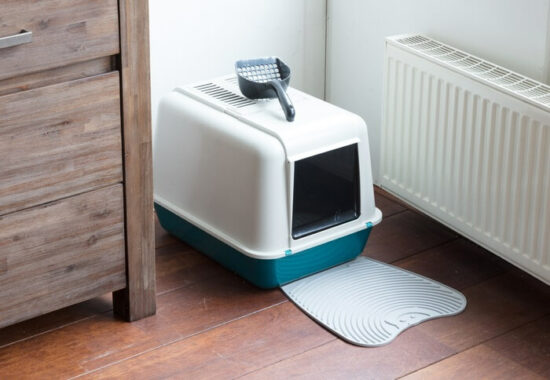Getting rid of gnats in a litter box seems impossible if you don’t know the right methods. These persistent little bugs never seem to go away!
This guide will teach you how to get rid of them, and how to keep them out. Don’t worry, it’s a lot easier than it looks.
Table of contents
Why Are Gnats Attracted To Litter Boxes?
When most people think of gnats, they picture rotting fruit or fermenting kitchen scraps. While these tiny bugs do flock to sweet and fruity scents, your cat’s litter box is just as appealing.
The most common type of gnats to invade the litter box is a fungus gnat. These are the same insects that like to hang around potted plants in your home.
They’re predominantly attracted to the waste in the litter. Both urine and feces are valuable sources of food for the bugs. Gnats will often burrow themselves in cat poop as they feed on the nutrients they need to survive.
Then they emerge, giving off the appearance that they “hatched” from the feces.
Quick Tip: Sometimes, it’s the litter itself that’s the problem. Vegetable-based litter products often use ingredients like corn or wheat. Even organic matter like coconut shavings or pine will attract gnats for its nutritional content.
Believe it or not, but gnats can also lay eggs in the litter box.
The wet and warm environment of a dirty litter box is perfect for eggs. In only a matter of days, the maggot-like larvae will emerge and make your kitty’s bathroom unusable for the time being.
It doesn’t take long before you have a massive population of annoying gnats in the litter box. If you live in a warm and humid environment, the issue can get even worse!
How To Get Rid Of Gnats In Litter Boxes
Gnats in the litter box can be a massive headache. Fortunately, they’re not too tricky to get rid of with a bit of know-how. Usually, it takes a couple of different methods to remove them.
Here are some techniques you can try to get rid of gnats in the litter box once and for all.
1. Clean The Litter Box Regularly
The first thing you should do? Clean out the litter box!
Gnats in the litter box will usually start to gather when waste sits for a while. Getting rid of both liquid and solid waste will do a lot to send them away. Of course, some will linger behind, but the bugs attracted to the organic waste will have no reason to stick around.
Clean out the box and the collection bin if you have one.
Don’t just limit your cleanup duties to sifting out the waste. Perform a deep clean!
Empty the entire receptacle and scrub it clean with some detergent. If you have it on hand, use some pet-safe sanitation products, too. Otherwise, you can get rid of germs with a thorough wash.
Ideally, it would be best if you cleaned the litter box out every day. Not every other day or a couple of times a week. You should clean and wash the litter box every single day!
We can’t stress that enough.
Quick Tip: Gnats don’t need long to lay eggs and multiply. Cleaning the litter box will disrupt the reproduction cycle and prevent more gnats from appearing.
2. Use Commercial Fly Traps
Fly traps are a surprisingly effective method for getting rid of gnats in a litter box when you use them correctly.
Most traps feature a sticky surface. It can be a simple cardboard tube or a long ribbon that you unravel. Either way, the surface is coated in a special glue that traps gnats the moment they’re unlucky enough to land on it.
You can hang the traps above the litter box where the gnats congregate. Just make sure it’s out of your cat’s reach. Felines can’t resist playing with a hanging toy, and the last thing you want to deal with is trying to wash glue out of your cat’s fur.
3. Set Up A Bug Zapper
Bug zappers can be hit or miss with gnats. These devices use an electrical current to fry flying insects on contact. Most zappers are designed for more giant insects like flies, mosquitos, and moths.
However, you might see some success with smaller models. Just place the zapper on a shelf somewhere above the litter box. Keep it out of reach from your cat, as that’s a nasty sting just waiting to happen!
4. Use Flying Insect Killer
Another commercial product you might consider buying is a spray insecticide. But don’t get a universal spray product. Instead, find one that targets flying insects.
These sprays have a built-in atomizer that spreads the chemicals in a fine mist. That way, you can quickly attack several gnats in one application.
The insecticide will coat the wings and quickly kill bugs in the litter box by disrupting their nervous system.
Once again, exercise caution here. Avoid spraying the chemicals into the litter, as it can irritate your cat’s paws when they use the litter box.
Quick Tip: Food-safe sprays are available as well. Instead of chemicals, they use all-natural oils. Those products are safe to use directly onto the liter.
5. Make An Alcohol Spray
If you prefer something a little more affordable and natural, you can use alcohol.
Fill a spray bottle with isopropyl alcohol and go to town attacking gnats and bugs that you find in the litter box! The alcohol will kill the gnats almost instantly. However, it also dries quickly and doesn’t cause any harm to your cat if they use the litter box later on.
Quick Tip: Try to use a bottle with a fine mist sprayer. The finer the alcohol particles, the more harmful the spray is against tiny flies.
Even if you don’t have any gnats in the immediate area, you can use the alcohol to clean the litter box. Give it a good spritz after washing to sanitize every surface and keep your cat’s bathroom bacteria-free.
6. Try A DIY Gnat Trap
If you’re in a pinch, DIY gnat traps can work wonders. They get the job done without having to spend much money at all. You have a few designs to try.
The first uses an old container, some cling film, and apple cider vinegar. Fill the container with warm water. Then, add a tablespoon of sugar, a drop of dishwashing soap, and a few tablespoons of vinegar.
Cover the opening of the container with cling film and use a toothpick to create a series of small holes.
The scent of the vinegar and sugar should attract the gnats. They’ll enter through the holes, get trapped in the container, and drown in the liquid below!
If that doesn’t work, you can try the candle trap. With this setup, you’ll need a large bowl of water and a candle. Set the candle in the bowl of water and light it up.
The flame should be above water level (and the whole trap should be in the vicinity of the litter box). The heat will kill the gnats and force them to fall into the water below. For some extra efficiency, add a few drops of soap into the water to prevent escape.
How To Keep Them Out In The Future
Now that you know how to get rid of the gnats in the litter box, let’s talk about how to keep them out.
Gnats are resilient little bugs that can quickly come back. Your cat’s litter box is a prime source of food and shelter for these flies. As long as that litter box is there, it has the potential to attract gnats.
However, there are several things you can do to ensure that they don’t bother you and your cat again.
Keep The Litter Box In The Right Environment
As we mentioned earlier, gnats prefer warm and humid environments.
Keep the litter box out of rooms that generate a lot of heat. Stick them in well-ventilated rooms with easy access to an air conditioner or fan.
Quick Tip: If possible, consider investing in a small dehumidifier. You can set the dehumidifier up in a designated room to keep the air as moisture-free and unappealing to gnats as possible.
Seal Potential Entry Points
Gnats can get in through all kinds of spaces. Thanks to their tiny size, they have no trouble with barriers like mesh or window screens.
Pay close attention to possible access points (especially near the litter box) and seal them up as much as possible. Use caulk around doors and windows. If your windows have screens, keep them closed to ensure that gnats don’t navigate through.
Use Less Cat Litter
While most cat lovers don’t realize it, they’re using way more litter than they need to. Cats can do just fine with only a thin layer of litter to work with.
Try cutting your litter usable by half. Doing so serves multiple purposes. First, it encourages you to keep the litter box clean. With only a little bit of litter available, you’ll have no choice but to wash and replenish the material more frequently.
Secondly, less litter provides less substrate for gnats to utilize for egg-laying. The gnats, eggs, and larvae will also be much easier to get rid of
Invest In An Automatic Litter Box
Have you ever seen one of those fancy electric litter boxes? They’re a fantastic tool for keeping gnats out of litter boxes.
These devices have a series of sensors that pick up when your cat comes in and out. After they do their business, the litter box will automatically pick up the waste. Usually, the spent litter goes into a sealed compartment that’s inaccessible to gnats and other insects.
They’re high-tech and pricey, but the benefits make it well worth the consideration!
Apply Repellents
Those who want to keep things simple can try using repellents. Like most insects, gnats are not keen on essential oils and strong odors. They particularly hate lavender, basil, rosemary, and other intense aromatics.
Use that to your advantage! You can create a simple essential oil spray with some water and vinegar. Use it liberally around the room to keep gnats and other insects out of the litter box.
Quick Tip: Alternatively, you can buy whole plants and arrange them around the room! Either way, the smell is usually enough to keep most gnats at bay.
Take Care Of Nearby Plants
Finally, don’t forget to check any indoor plants. The same gnats that get into your cat’s litter box are causing trouble to nearby potted plants.
Consider replenishing the soil and changing your watering habits to encourage drying and adequate drainage. If the gnats become too much of a problem, you might want to move the potted plant.
Is It Dangerous Or Unhealthy?
Gnats in a litter box are more than just a minor annoyance. While it’s rare, these flies are fully capable of spreading disease-causing pathogens throughout your house.
Your pets would be the first to feel the ill effects of gnats. These bugs can get on your cat’s paws and eventually spread to their fur. There, they cause itchiness and irritation.
Eventually, your cat will spread the gnats throughout your home.
It doesn’t take before the gnats reach you, your children, and everyone else in the home. All it takes is you not washing your hands before touching your face for things to go awry. The flies can carry parasites, bacteria, and disease vectors.
They’re not something you want to ignore. A large population of gnats in a litter box can create an unsanitary and potentially dangerous environment in your home.
Conclusion
If you have a cat, learning how to get rid of gnats in their litter box is an essential skill you should develop. Fortunately, it’s just a matter of knowing the right methods to try.
Let us know if you have any questions about taking care of these annoying little bugs (or keeping them out). We’re always happy to help our readers!


